Consider investing in target-date retirement funds
Recently, a man in his early 50s asked me to review his retirement plan. A senior manager at a large employer, he had just paid off all of his debts and set his sights on saving and investing for a successful retirement at age 70. So far, so good. But when I reviewed his investments in his company’s 401(k), I grew concerned.
His entire 401(k) savings were in a very specific fund, small-cap U.S. value stocks, and these funds carry inherent (yet somewhat hidden) risks. Not only did he have overall stock market risk, but he also had investment style risk — or, in other words, the chance that returns from these small-cap value stocks will trail returns of the overall stock market.
When I asked him why he chose this particular fund, and why he put all of his money in it, he thought for a moment and replied, “I have no idea.” He wasn’t familiar with the fund at all and didn’t know the associated risks. Makes sense: He had very little investment experience. But he was allowed to make this choice simply because it was available in the fund lineup within his company’s 401(k) plan.
My general advice for most folks who are saving for retirement is to find an asset allocation of broadly diversified stocks, bonds, cash and other investments that align with your risk tolerance, time horizon and financial goals. But many times that’s not what happens.
For people like him who are confronted with investment choices within the confines of a 401(k) but lack the information to make a reasonable investment decision, I generally encourage them to consider target-date retirement funds.
A target-date retirement fund is a single investment option that allows retirement savers to hold a diversified mix of asset classes, carefully put together by professional portfolio managers, with an approximate date planned to start withdrawing assets. These funds invest more aggressively in the decades before retirement and, over time, shift to a more conservative mix as retirement approaches. That shift is called the “glidepath.”
Target-date funds got their start in the early 1990s and have grown in popularity ever since, accounting for about $1.4 trillion in assets by the end of 2019, according to data from Morningstar. Much of their growth may be attributable to the Pension Protection Act of 2006, which encouraged 401(k) plan sponsors to enroll participants automatically and to allocate their investments to a default option. In many cases, that default option has become target-date retirement funds.
If your company’s 401(k) offers target-date retirement funds, you may only have one fund family to choose from. Still, it’s important to ask the following questions when evaluating a target-date fund:
No. 1: What is the shape of the glidepath? Funds can vary dramatically in their approach. A recent Morningstar study found that there was tremendous variation and a lack of consistency in asset allocations. For instance, funds in the 2026-2030 retirement category had equity allocations anywhere between 40 and 75 percent, with a median allocation of 64 percent.
No. 2: What happens to the glidepath at retirement? There are “to” funds and there are “through” funds. The “to” funds maintain a static asset allocation once the retirement date is reached, whereas the “through” funds emphasize a declining glidepath well after your retirement.
No. 3: Is the target-date fund diversified beyond stocks and bonds, including other asset classes like real estate and commodities? So-called alternative asset classes may either enhance or diminish the risk-and-return profile, and a movement is afoot to get private equity funds into 401(k) plans. I’m a little skeptical that this can be done successfully and at a reasonable price, but we shall see.
Even if you have a lot of investment experience and feel confident making fund choices within your 401(k), you may find target-date retirement funds useful simply for the convenience they provide. For instance, the funds are rebalanced periodically to maintain the integrity of their risk-and-return profile. This is done automatically for you. By contrast, if you pick a bunch of funds yourself in your 401(k), you have to be sure to rebalance periodically. In my experience, many people forget to do this.
If you’re looking for target-date funds with an ESG — or environmental, social and governance — investment approach, they’re still a bit hard to find in many employer’s 401(k) plans right now. But if enough 401(k) participants begin to ask for this option, it may be that we see some progress in this area.
You’ll often see target-date funds offered outside of 401(k) plans as well. For example, some people invest in a target-date retirement fund through their HSA, or Health Savings Account. They like the convenience of having one well-diversified fund handling their monthly HSA contributions, as well as the hands-off approach of knowing the fund will gradually become more conservative as they approach their own retirement, at which point they will begin withdrawals.
Published in Asheville Citizen Times, Sun. January 24, 2021
Bray Creech, MBA, CPA is a CERTIFIED FINANCIAL PLANNER™ professional with Joel Adams & Associates with securities offered through Raymond James Financial Services, Inc. Member FINRA/SIPC and is located at 545 Merrimon Avenue, Asheville, NC. He can be contacted at 828-251-9700 or bray.creech@raymondjames.com. CPA services are not offered through Raymond James. Investment advisory services offered through Raymond James Financial Services Advisors, Inc. Joel Adams & Associates is not a registered broker/dealer and is independent of Raymond James Financial Services, Inc.
Opinions expressed in the article are those of the author and are not necessarily those of Raymond James. The information contained in this report does not purport to be a complete description of the securities, markets, or developments referred to in this material. The information has been obtained from sources considered to be reliable, but we do not guarantee that the foregoing material is accurate or complete. Investing involves risk and investors may incur a profit or a loss. Past performance may not be indicative of future results. Raymond James does not provide tax or legal services. Please discuss these matters with the appropriate professional.
Target retirement date (lifestyle) investment options are designed for participants who plan to withdraw the value of their accounts gradually after retirement. Each of these options follows its own asset allocation path (“glidepath’) to progressively reduce its equity exposure and become more conservative over time. Options may not reach their most conservative allocation until after their target date. Investors should consider their own personal risk tolerance, circumstances and financial situation.
Investments available to HSA holders are subject to risk, including the possible loss of the principal invested and are not federally insured or guaranteed. HSA holders making investments should review the applicable fund’s prospectus. Investment options and thresholds may vary and are subject to change. Consult your advisor or the IRS with any questions regarding investments or on filing your tax return. Before making any investments, review the fund’s prospectus.

